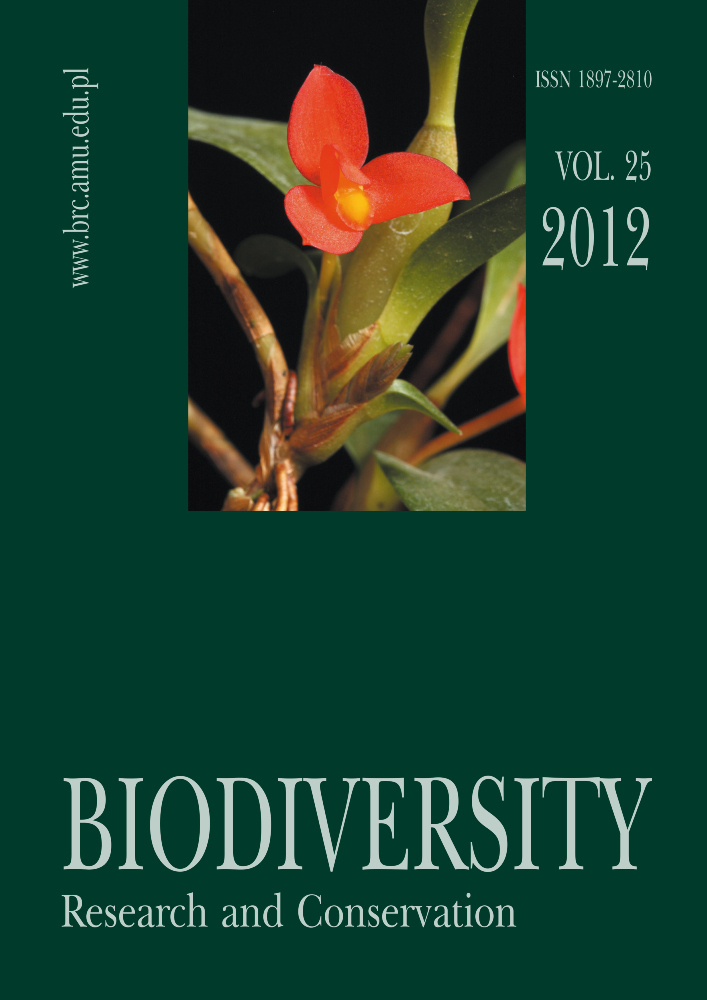Abstract
A list of 232 taxa of lichenized and lichenicolous fungi was recorded within the Wolin island, especially, the Wolin National Park. The findings comprise the results of field studies conducted between 1996 and 2008 and those published in earlier works. Some of them are rare in the Polish lowlands.
References
CIEŚLIŃSKI S., Czyżewska K., Faliński, J. B., Klama H., Mu£enko W. & Żarnowiec J. 1996. Relicts of the primeval (virgin) forest. Relict phenomena. In: J. B. Fali-ski & W. Mu£enko (eds.). Cryptogamous plants in the forest communities of Bia≥owieøa National Park. Phyto-coenosis 8 (N.S.) Seminarium Geobotanicum 4: 47-64.
CIEŚLIŃSKI S., Czyżewska K. & Fabiszewski J. 2006. Red list of extinct and threatened lichens in Poland. In: Z. Mirek, K. Zarzycki, W. Wojewoda & Z. Szeląg (eds.). Red list of plants and fungi in Poland, pp. 71-89. W. Szafer Institute of Botany, Polish Academy of Sciences, KrakÛw.
Czyżewska K. 1997. Materia≥y sympozjum i obrad sekcji Lichenologicznej PTB. Za≥Ícze 1997.
Czyżewska K. & CIEåLI-SKI S. 2003. Lichens ñ indicators of lowland old ñ growth forests in Poland. Monographiae Botanicae 91: 223-239.
Czyżewska K. & Kukwa M. 2009. Lichenicolous fungi of Poland. A checklist and key to species. In: Z. Mirek (ed.). Biodiversity of Poland, 11, 2009. 133 pp. W. Szafer Institute of Botany, Polish Academy of Sciences, KrakÛw.
Diederich P., Ertz D., Stapper N., S…rusiaux E. & Ries C. 2011. The lichens and lichenicolous fungi of Belgium, Luxembourg and northern France. URL: http://www.lichenology.info [date of exploration: January 2011].
Dziabaszewski B. 1962. Lichens of the Wolin Island with particular refernce to the National Park. PTPN, Prace Komisji Biologicznej 32(5): 1-48.
Ertz D. & Tehler A. 2011. The phylogeny of Arthoniales (Pezizomycotina) inferred from nucLSU and RPB2 sequences. Fungal Diversity 49: 47-71.
Falińska K. 1996. Ekologia Roúlin. 453 pp. PWN, Warszawa.
Fałtynowicz W. 1992. The lichens of Western Pomerania (NW Poland) ecogeographical study. Polish Bot. Stud. 4, 182 pp. KrakÛw.
Piotrowska H. 1955. Les associations forestires de lile Wolin. 168 pp. PWN, PoznaÒ.
Purvis O., Coppins B., Hawksworth D., James P. & Moore D. 1992. The Lichen Flora of Great Britain and Ireland. 710 pp. Natural Museum Publications, London.
Santesson R, Moberg R., Nordin A., TÿNSBERG T. & Vitikainen O. 2004. Lichen- forming and lichenicolous fungi of Fennoscandia. 359 pp. Museum of Evolution, Uppsala University.
Smith C. W., Aptroot A., Coppins B. J., Fletcher A., Gilbert O. L., James P. W. and Wolseley P. A. 2009. The Lichens of Great Britain and Ireland. 1046 pp. Natural Museum Publications, London.
Wirth W. 1995. Die flechten Baden-W¸rttembergs. 1006 pp. E. UlmerVerl., Stuttgart.
Zajac A. 1978. Atlas of distribution of vascular plants in Poland (ATPOL). Taxon 27(5-6): 481-484.




